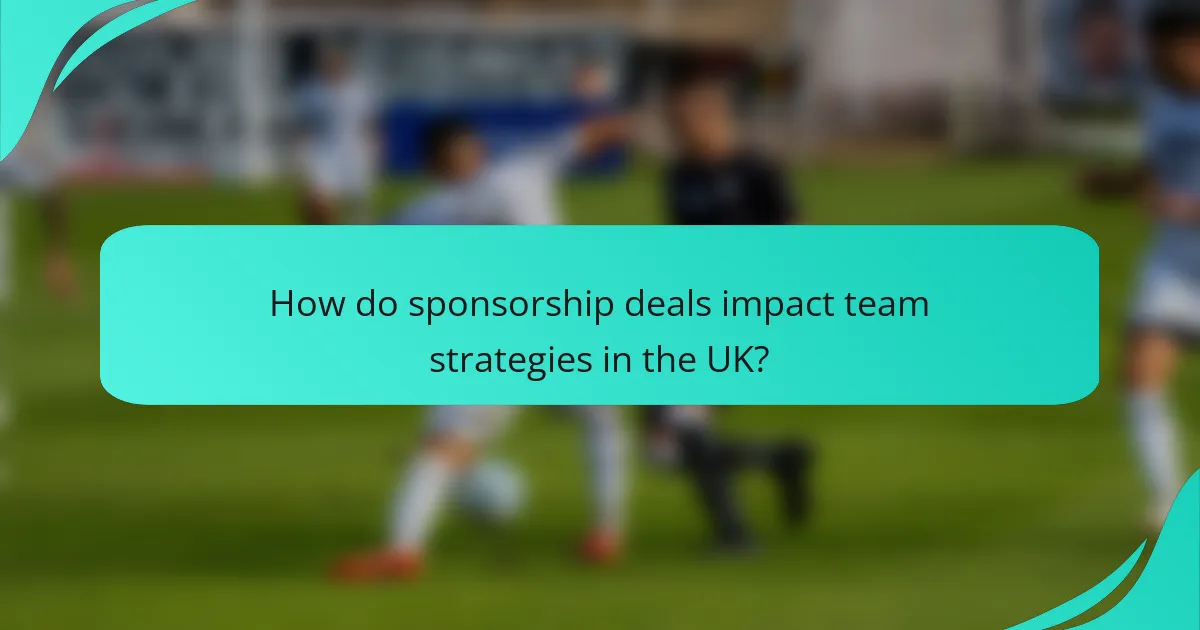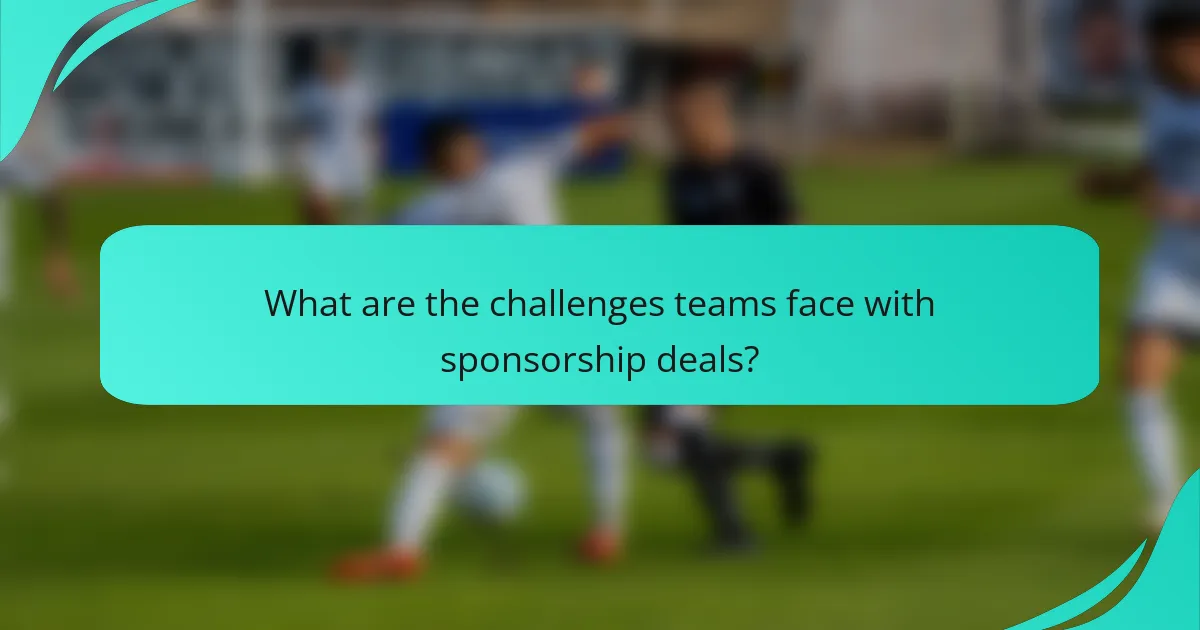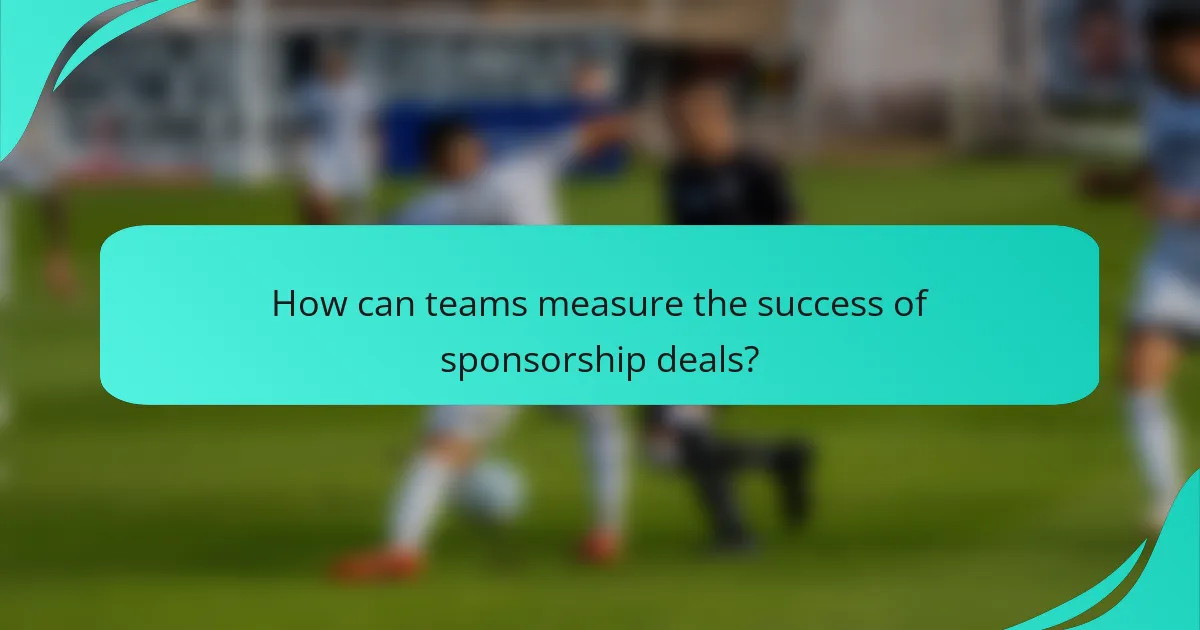Sponsorship deals play a crucial role in shaping team strategies and fostering growth by providing vital funding and resources. These partnerships not only enhance a team’s market presence and financial stability but also allow for investments in key areas such as talent acquisition and facility improvements, ultimately driving competitive advantage.

How do sponsorship deals impact team strategies in the UK?
Sponsorship deals significantly influence team strategies in the UK by providing essential funding and resources that shape operational decisions and growth trajectories. Teams leverage these partnerships to enhance their market presence, improve financial stability, and attract top talent.
Increased revenue for operational budgets
Sponsorship deals contribute to increased revenue, which directly impacts a team’s operational budget. This additional funding can be allocated towards facilities, training, and overall team development.
For instance, a football club might secure a sponsorship deal worth millions of pounds, allowing them to invest in state-of-the-art training facilities or upgrade their stadium. This financial boost can enhance the team’s competitive edge in the league.
Enhanced brand visibility and marketing opportunities
Through sponsorships, teams gain enhanced brand visibility and marketing opportunities that can elevate their profile. Sponsors often promote their partnerships through various channels, increasing the team’s exposure to wider audiences.
For example, a rugby team partnered with a well-known beverage brand may feature the sponsor’s logo prominently on their jerseys and marketing materials, attracting new fans and potential customers. This visibility can lead to increased merchandise sales and fan engagement.
Influence on player recruitment and retention
Sponsorship deals can significantly influence player recruitment and retention strategies. A financially stable team backed by strong sponsorships can offer competitive salaries and benefits, making it more attractive to potential recruits.
Moreover, established sponsorships can enhance a team’s reputation, making it easier to retain top talent. Players are often drawn to teams that demonstrate financial health and a commitment to success, which is frequently supported by robust sponsorship arrangements.

What are the key factors in negotiating sponsorship deals?
Key factors in negotiating sponsorship deals include understanding the market value of the team, ensuring brand alignment with audience demographics, and defining contract length along with exclusivity terms. These elements significantly influence the potential success and growth of the partnership.
Market value of the team
The market value of a team is a critical factor in sponsorship negotiations, as it reflects the team’s overall worth and potential revenue generation. Factors such as team performance, fan engagement, and historical success contribute to this valuation. Teams with higher market values can command more substantial sponsorship deals.
When assessing market value, consider recent sales of similar teams, average ticket prices, and merchandise sales. This information can provide a benchmark for negotiations, helping teams to justify their asking price to potential sponsors.
Brand alignment and audience demographics
Brand alignment refers to how well a sponsor’s values and target audience match those of the team. Successful sponsorships often occur when both parties share similar goals and can engage the same demographic. This alignment enhances the effectiveness of marketing campaigns and increases the likelihood of a successful partnership.
Understanding audience demographics is essential for both teams and sponsors. Teams should provide potential sponsors with data on their fan base, including age, gender, location, and purchasing behavior. This information helps sponsors tailor their marketing strategies and ensures that the partnership resonates with the target audience.
Contract length and exclusivity terms
Contract length is a vital consideration in sponsorship deals, as it dictates the duration of the partnership and the stability of the financial commitment. Longer contracts can provide sponsors with extended visibility, while shorter contracts may allow for more flexibility to adapt to changing market conditions.
Exclusivity terms are equally important, as they determine whether a sponsor will be the only brand represented in a specific category. Exclusive deals can be more lucrative for teams but may limit the sponsor’s ability to collaborate with other entities. Both parties should carefully negotiate these terms to ensure mutual benefit and satisfaction.

How do sponsorship deals affect team growth in Europe?
Sponsorship deals significantly influence team growth in Europe by providing essential funding that supports various strategic initiatives. These partnerships enable clubs to invest in key areas such as youth development, fan engagement, and facility improvements, ultimately enhancing their competitive edge and market presence.
Investment in youth development programs
Sponsorship deals often allocate funds specifically for youth development programs, which are crucial for nurturing future talent. By investing in academies and training facilities, teams can cultivate homegrown players who may eventually contribute to the first team or be sold for profit. This approach not only strengthens the squad but also fosters a loyal fan base that values local talent.
For instance, clubs like Ajax and Barcelona have successfully utilized sponsorship funds to enhance their youth systems, resulting in a steady stream of skilled players. Teams should prioritize partnerships that emphasize youth development to ensure long-term success.
Expansion of fan engagement initiatives
Sponsorship deals enable teams to expand their fan engagement initiatives, creating a more interactive and loyal supporter base. Investments in digital platforms, community events, and merchandise can enhance the overall fan experience, making it more accessible and enjoyable. Engaging fans through social media campaigns and exclusive content can also strengthen their connection to the club.
For example, clubs may partner with brands to host fan festivals or interactive online events, which can significantly boost attendance and merchandise sales. Teams should seek sponsorships that align with their fan engagement goals to maximize impact.
Improvement in facilities and infrastructure
Financial backing from sponsorship deals often leads to significant improvements in team facilities and infrastructure. Upgrading stadiums, training grounds, and medical facilities can enhance player performance and attract top talent. Modern facilities also provide a better experience for fans, which can increase attendance and revenue.
Clubs like Manchester City have invested heavily in their infrastructure through sponsorship deals, resulting in state-of-the-art training complexes. Teams should evaluate potential sponsorships based on the ability to fund facility enhancements that align with their growth strategies.

What are the challenges teams face with sponsorship deals?
Teams encounter several challenges with sponsorship deals, including aligning sponsor expectations with their own values, managing public perception, and ensuring compliance with relevant regulations. These factors can significantly impact a team’s strategy and growth trajectory.
Balancing sponsor demands with team values
Teams must navigate the delicate balance between fulfilling sponsor demands and staying true to their core values. This often involves negotiating terms that align with the team’s mission while still providing value to the sponsor.
For example, a sports team may receive pressure to promote a product that conflicts with their commitment to health and wellness. Teams should carefully evaluate sponsorship opportunities to ensure they resonate with their audience and uphold their brand integrity.
Managing public perception and backlash
Public perception plays a crucial role in the success of sponsorship deals. Teams need to be proactive in managing how sponsorships are viewed by fans and the broader community. Negative reactions can arise if a sponsor’s reputation does not align with the team’s values.
To mitigate backlash, teams should engage with their fan base and communicate transparently about sponsorship choices. Monitoring social media sentiment and addressing concerns promptly can help maintain a positive image.
Ensuring compliance with regulations
Compliance with local regulations is essential when entering sponsorship deals. Teams must be aware of advertising laws, sponsorship guidelines, and any industry-specific regulations that may apply. This is particularly important in regions with strict advertising standards, such as the European Union.
Teams should consult legal experts to ensure all sponsorship agreements are compliant and to avoid potential penalties. Regular audits of sponsorship contracts can also help identify any compliance issues before they escalate.

How can teams measure the success of sponsorship deals?
Teams can measure the success of sponsorship deals by evaluating financial performance, fan engagement, and brand awareness. These metrics provide insights into how effectively a sponsorship contributes to a team’s growth and overall strategy.
Tracking revenue growth and ROI
To assess the financial impact of sponsorship deals, teams should track revenue growth and return on investment (ROI). This involves comparing income generated from sponsorships against the costs associated with securing those deals.
Common methods include analyzing ticket sales, merchandise revenue, and any increases in overall team revenue attributed to sponsorships. A positive ROI typically indicates a successful partnership, while a negative ROI may signal the need for strategic adjustments.
Analyzing fan engagement metrics
Fan engagement metrics are crucial for understanding how sponsorships resonate with the audience. Teams can measure engagement through social media interactions, attendance at events, and participation in promotional activities.
For example, tracking social media mentions and likes can reveal how well a sponsor’s brand is received by fans. High engagement levels often correlate with successful sponsorships, as they indicate that fans are connecting with both the team and the sponsor.
Evaluating brand awareness through surveys
Surveys are an effective way to evaluate brand awareness resulting from sponsorship deals. Teams can conduct pre- and post-sponsorship surveys to gauge changes in fans’ recognition and perception of the sponsor’s brand.
Questions may include how familiar fans are with the sponsor and whether they associate the brand with positive attributes. This feedback can help teams and sponsors refine their strategies to enhance brand visibility and alignment with fan values.
